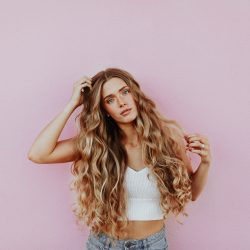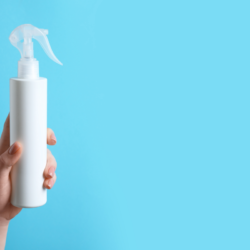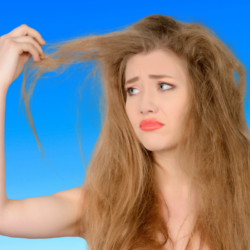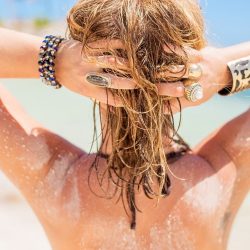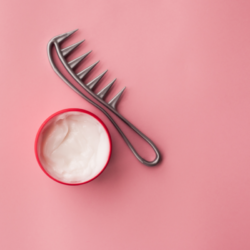Unlike straight hair, curly hair tends to dry out easily. In fact, it lacks moisture, which makes it difficult to maintain on a daily basis. If you’re looking to give your natural curls more bounce, hold and shine , you’ve definitely come to the right place!
Understanding curly hair
Curly hair is a fascinating and complex world. To care for it properly, it’s essential to understand its unique characteristics and the fundamental differences with other hair types.
Characteristics of curly hair
Curly hair naturally has a spiral structure that gives it distinctive volume and shape. This unique structure is not simply a matter of aesthetics; it has a major influence on how the hair reacts to conditioning products and the environment.
One notable aspect of curly hair is its tendency to dry out. The spiral shape prevents the sebum produced by the scalp from being distributed evenly along the hair shaft, so curls are often less moisturised than straight hair. This makes them susceptible to frizz and breakage, requiring regular moisturising and nourishing care.
Curly hair is also generally more porous. Porosity refers to the hair’s ability to absorb and retain moisture. This characteristic has a direct impact on the way hair reacts to moisturising products and climatic conditions, such as humidity.
Differences with other hair types
Compared to straight or wavy hair, curly hair requires a different approach to care. While straight hair can often tolerate frequent washing without becoming too dry, curly hair benefits from less frequent washing to preserve its natural oils. In addition, styling techniques differ; for example, excessive use of brushes can disrupt the natural shape of curls and cause frizz.
Compared to wavy hair, curls tend to require richer, more moisturising products to maintain their shape and elasticity. Wavy hair, which lies somewhere between straight and curly, can sometimes adopt care routines more akin to those of straight hair.
Understanding these distinctive aspects is essential to developing a hair care routine that respects and embellishes the unique nature of curly hair. Every hair type has its own specific needs, and curly hair is no exception. With the right care and attention, it can truly flourish and radiate health.
What are the different types of curls?
Many people think there’s only one type of curly hair. In fact, there are several!
Curls with a very relaxed texture are called “waves“. Then there are ‘curls‘, which are more defined. They are said to form spirals. And finally, frizzy hair is when the curls are tightly wound. The more you know about your hair type, the better you can look after it on a daily basis. These days, there are many cosmetic products that claim to be able to solve all our hair problems at the snap of a finger. However, not all products will work on all hair types.
Curly hair suffers from the same problems as all other hair: split ends, frizz, brittle hair, dry or greasy hair, loss of curl definition, texture problems …. To choose the ideal routine for the health of your hair, you need to understand it!
What’s the difference between curly and wavy hair?
Curly hair forms a complete 360-degree spiral. Wavy hair, on the other hand, is S-shaped. The waves created by this type of hair can take the form of loose spirals or a corkscrew appearance. However, they don’t form tight curls like curly hair does. Here’s how to tell the difference between curly and wavy hair!
Should I dry my curly hair with a hairdryer?
Have you noticed how beautiful your curly hair looks straight out of the shower? Take a closer look at your well-defined curls! As you can imagine, hair is at its best when it’s full of water. Then, when we start using this or that product, touching it, drying it, moving the curls from one side to the other… our curls are transformed. Drying curls is not something to be taken lightly!
Air drying
For perfect curls, air-drying is an excellent option. For optimum curl definition, follow the guide:
- Gently wrap your hair in a microfibre towel or old T-shirt for about ten minutes over your head to remove excess moisture. Without rubbing or pulling your hair!
- Apply your leave-in curl cream, concentrating first on the ends and then on the lengths. You can use a curling brush to distribute the product more evenly. The aim is to nourish 100% of the hair (remember, well-hydrated hair = beautiful curls = less chance of frizz)
- Don’t touch your hair! If you touch your hair while it’s air-drying, it will create frizz.
- You can also use a gel as a final step to seal in the moisture inside the curls and help them stay defined
- Once all your hair is dry, you can ‘break’ the cardboard effect left by the gel, simply by crushing your curls in the palm of your hands (I like to use a little jojoba oil at this point to coat the hair and give it even more shine without weighing it down)
Use a diffuser
Not everyone wants to have their head damp for hours on end, and some situations call for hair to be dry and styled fairly quickly. Using a diffuser nozzle on a hairdryer can speed up this process while preserving curls.
- All you need to do is repeat the same steps as for air-drying: wash, ‘spin’, apply products with a brush, etc
- Start by drying the hair at the roots using the diffuser, taking care to always direct the airflow downwards to prevent frizz
- Then, when your hair is almost completely dry, turn your head upside down, place your curls in the diffuser and turn it on
- Always diffuse your curls at a low temperature to protect them from heat damage.
- Repeat this process in sections until all your hair is finished.
Managing common curly hair problems
Curly hair, while beautiful, often faces specific challenges, including frizz and dryness. Understanding and treating these problems is essential to keeping curls healthy and beautiful.
Frizz
Frizz is a common plague for people with curly hair. It occurs when external moisture penetrates the hair shaft and disrupts the structure of the proteins in the hair, causing the strands to expand and become disordered in texture. This phenomenon is particularly pronounced in people with porous or damaged hair.
Solutions:
- Deep Hydration: Using moisturising masks and hair oils can help to deeply nourish hair and seal in moisture, reducing frizz.
- Anti-Frizz Products: Serums and creams specifically formulated to combat frizz can be applied to damp hair to help smooth the cuticle.
- Gentle Drying Techniques: Avoid aggressive towel-drying in favour of air-drying or using a low-temperature diffuser to minimise disruption to the hair cuticle.
Dryness
Dryness is another common challenge, often resulting from the spiral structure of curly hair, which prevents the natural sebum from being distributed evenly throughout the hair. This can leave hair dull, rough and prone to breakage.
Solutions:
- Gentle Shampoos: Opt for gentle, sulphate-free shampoos to cleanse without stripping hair of its natural oils.
- Nourishing Conditioners and Masks: Use products rich in moisturising agents and nutrients to deeply nourish hair.
- Natural oils: Applying oils such as coconut oil, argan oil or jojoba oil can help replenish moisture and seal in moisture.
- Spacing out washes: Space out washes to allow natural oils to nourish the hair.
By adopting the right hair care routine and specifically treating frizz and dryness, it’s possible to transform unruly, dry curls into defined, supple, shiny curls. The key is to understand and respect the unique needs of your curly hair, providing it with the moisture, nutrition and protection it needs to thrive.
Pre poo and curly hair?
Understanding the importance of pre poo for curly hair is an essential part of maintaining the health and vitality of your curls. This pre-shampoo hair treatment can do wonders to nourish, hydrate and detangle your curly hair, while protecting it from the excessive dryness caused by some shampoos. Pre poo treatments infuse your hair with natural oils and nutrients, strengthening the moisture barrier and reducing frizz. Curly hair that is regularly treated with pre poo will be more defined, shinier and more resilient. So the importance of pre poo for curly hair shouldn’t be overlooked in your hair care routine.
Food supplements for healthy hair
Many people consider healthy hair to be a true symbol of health as well as beauty. What’s more, like the rest of the body, hair needs a multitude of vitamins and minerals to grow and shine with vitality. Although factors such as age, genetics and hormonal profile play an important role in hair growth, taking dietary supplements specially designed for hair health is essential.
- Vitamin B complex
- Vitamin C
- Vitamin D
- Iron
- Zinc
FAQ
Q1: What are the different types of curly hair mentioned in the text?
A1: The text mentions three types of curly hair. First, there are “waves”, which are curls with a very relaxed texture. Then there are ‘curls’, which are more defined and take the form of spirals. Finally, frizzy hair is hair with very tight curls.
Q2: What’s the difference between curly and wavy hair?
A2: Curly hair forms a full 360-degree spiral, while wavy hair takes on an S shape. Waves can look like loose spirals or corkscrews, but they don’t form a tight curl like curly hair does.
Q3: How should I dry my curly hair to maintain its shape?
A3: The text recommends air drying. After removing excess moisture with a microfibre towel or old T-shirt, you can apply a leave-in curl cream. It’s important not to touch your hair while drying to avoid frizz. You can also use a gel to help maintain the shape of your curls.
Q4: How do I use a diffuser to dry curly hair?
A4: After following the same steps as for air-drying (washing, ‘spinning’, applying products), you can start by drying the roots with the diffuser, always directing the airflow downwards. Then, when the hair is almost dry, turn your head upside down, place your curls in the diffuser and turn it on low. Repeat this process until all your hair is dry.
Source:
- https://www.ncbi.nlm.nih.gov/pmc/articles/PMC5328807/
- https://www.ncbi.nlm.nih.gov/pmc/articles/PMC6894537/
- https://pubmed.ncbi.nlm.nih.gov/28370528/
- https://pubmed.ncbi.nlm.nih.gov/12789164/
- https://pubmed.ncbi.nlm.nih.gov/34785008/
- https://ods.od.nih.gov/factsheets/Zinc-HealthProfessional/
- https://pubmed.ncbi.nlm.nih.gov/35415182/
- https://www.ncbi.nlm.nih.gov/pmc/articles/PMC5315033/
@soin.et.nature ✨ Tu veux une routine capillaire naturelle pour des boucles parfaitement définies et nourries ????♀️ Teste les produits bio d’Avril Cosmétique, pour des cheveux au top de leur forme ! ✨️ rdv sur www.soin-et-nature.com ??♀️ #cheveuxbouclés #routinecapillaire #beauté #curlyhairdontcare #AvrilCosmétique ✨ #cheveuxbouclés #routinecapillaire #beauté #curlyhairdontcare #cheveuxbouclés #routinecapillaire #soinscapillaires #coiffure #beauté #cheveuxfrisés #cheveuxnaturels #produitscapillaires #curlyhairdontcare #boucles #coiffurecheveuxbouclés #salondecoiffure #prendresoindesoi #hydratationcheveux #conseilsbeauté #curlygirlmethod #bowlmethod #denmanbrush #coiling


